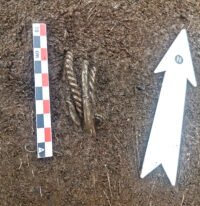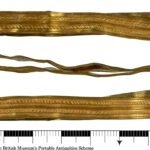 A hoard of four Viking Age silver bangles has been unearthed on a mountainside at a farm in Årdal in Hjelmeland municipality, Norway. Each of them are of a different style and in excellent condition. They were found less than eight inches under the surface so close together than they overlapped each other, so there is no question they have not been disturbed since they were buried in the 9th century.
A hoard of four Viking Age silver bangles has been unearthed on a mountainside at a farm in Årdal in Hjelmeland municipality, Norway. Each of them are of a different style and in excellent condition. They were found less than eight inches under the surface so close together than they overlapped each other, so there is no question they have not been disturbed since they were buried in the 9th century.
“This is a unique find, because we very rarely find such objects exactly where they were placed. As a rule, such valuable objects are discovered on fields that have been plowed, where an object has been completely taken out of its original context. Since the silver hoard has not been moved, it can give us completely new insights into life and society in the Viking Age,” says [lead archaeologist Volker] Demuth.
The excavation was initiated when the landowner, farmer Tårn Sigve Schmidt, called in archaeologists to survey the route of a tractor road he was planning to build up the mountain. Archaeologists found evidence of an extensive Viking farm, including dwellings for people and outbuildings for animals. Artifacts discovered include fragments of soapstone pots, rivets, knife blades and whetstones.
 The silver bangles were found under what was once the floor of a small house. The dwelling is so small and spare that archaeologists believe it probably housed enslaved workers, and there were no other artifacts discovered in the area. The excavation found evidence that the farm was burned down around the time the silver bracelets were buried. The people who lived at the farm may have therefore buried the hoard before they fled an attack, and chosen an unlikely location to deter looters.
The silver bangles were found under what was once the floor of a small house. The dwelling is so small and spare that archaeologists believe it probably housed enslaved workers, and there were no other artifacts discovered in the area. The excavation found evidence that the farm was burned down around the time the silver bracelets were buried. The people who lived at the farm may have therefore buried the hoard before they fled an attack, and chosen an unlikely location to deter looters.
 The bracelets are similar in style to six Viking silver neck rings now in the Archaeological Museum in Stavanger that were discovered in 1769 at another farm in Hjelmeland. They were likely deposited as ritual sacrifices to mark or seal the boundaries of a settlement. They were not associated with a grave, and indeed no silver neck rings have ever been found in a Viking grave. That might suggest another motivation for the burial of the rings. According to Odin’s Law, as recorded in the Heimskringa saga, men were allowed to bring with them to Valhalla everything that was burned on the funeral pyre with them and anything they had personally buried in the ground.
The bracelets are similar in style to six Viking silver neck rings now in the Archaeological Museum in Stavanger that were discovered in 1769 at another farm in Hjelmeland. They were likely deposited as ritual sacrifices to mark or seal the boundaries of a settlement. They were not associated with a grave, and indeed no silver neck rings have ever been found in a Viking grave. That might suggest another motivation for the burial of the rings. According to Odin’s Law, as recorded in the Heimskringa saga, men were allowed to bring with them to Valhalla everything that was burned on the funeral pyre with them and anything they had personally buried in the ground.
 The bracelets were not fully excavated at the site, but rather removed in a soil block for micro-excavation in laboratory conditions at the Archaeological Museum of the University of Stavanger. Conservators have x-rayed the block and will take samples of the soil for evidence of any organic material, like a bag or a cloth, that the bracelets were wrapped in before burial. The hoard will be put on display at the museum when study and conservation is complete.
The bracelets were not fully excavated at the site, but rather removed in a soil block for micro-excavation in laboratory conditions at the Archaeological Museum of the University of Stavanger. Conservators have x-rayed the block and will take samples of the soil for evidence of any organic material, like a bag or a cloth, that the bracelets were wrapped in before burial. The hoard will be put on display at the museum when study and conservation is complete.







